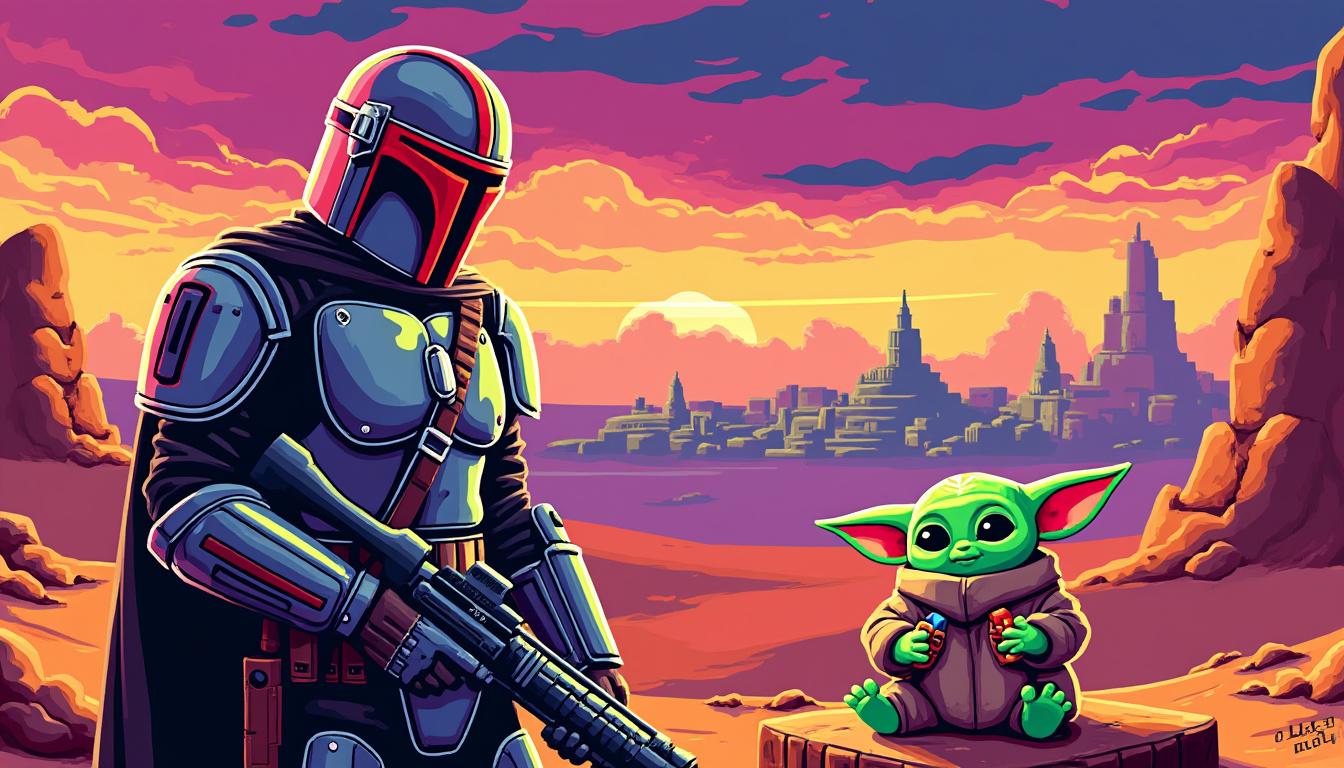The landscape of Star Wars continues to evolve, and one of its most exciting recent developments is the cinematic work of David Klein, who is set to leave an indelible mark on the universe with his role in ‘The Mandalorian and Grogu’. This film not only represents a continuation of beloved narratives, but also showcases innovative cinematography that meshes seamlessly with the previously established aesthetic of the franchise. As the director of photography for this production, Klein’s extensive experience and methodical approach promise to craft visually stunning sequences that will resonate with audiences and enhance the storytelling.

David Klein’s Role and Influence in the Star Wars Universe
David Klein has cemented his position in the Star Wars legacy, contributing significantly to the cinematic vision of the franchise. Through his work as the director of photography on multiple projects within the MandoVerse, including ‘The Mandalorian’ and ‘The Book of Boba Fett’, he has displayed a remarkable ability to blend visual style with narrative depth. His expertise lends itself well to capturing the essence of characters like Grogu and the Mandalorian, ensuring their journeys are presented with both grandeur and intimacy.
Klein’s journey into the realm of Star Wars has been marked by a series of significant contributions:
- Director of photography for eight episodes of ‘The Mandalorian and Grogu’ across two seasons.
- Contributed to five episodes of ‘The Book of Boba Fett’.
- Worked on four episodes of ‘Skeleton Crew’, thus expanding his influence within the franchise.
This extensive experience is also coupled with a rich background in filmmaking, having honed his craft over three decades and collaborated with esteemed directors such as Kevin Smith. These early projects provided him with a unique perspective on visual storytelling, which he now applies to the vast canvas of Star Wars.
Klein’s approach often involves utilizing advanced technologies such as ILM’s visual effects and Blackmagic Design cameras, which enhance the immersive experience he seeks to create. His collaborations exemplify how precise technical execution can elevate a narrative, producing films that not only display action but also evoke a sense of wonder.
Technological Innovations in Cinematography
The technical ingenuity present in Klein’s cinematography cannot be overstated. The Mandalorian series is particularly notable for its use of The Volume, an impressive combination of LED screens and real-time rendering technology that allows for dynamic backgrounds and environments. This innovation not only enhances visual fidelity but creates a more authentic atmosphere for actors and crews alike.
Key elements of this technological advancement include:
- Immersive environments: The Volume allows for realistic backgrounds that react to lighting changes in real time, creating an interactive set.
- Enhanced performance: Actors are able to perform in settings that respond visually to their actions, resulting in more genuine performances.
- Cost efficiency: This technology reduces the need for extensive location shooting, allowing for quicker production schedules and reduced logistics.
This method reflects a significant shift in cinematographic practices, aligning closely with the evolving demands of modern cinema. David Klein’s adept utilization of these tools signifies a willingness to embrace innovation for enhanced storytelling means.
Key Lessons from Klein’s Cinematic Approach
Analyzing Klein’s cinematic techniques reveals several invaluable lessons for aspiring filmmakers within the Star Wars realm and beyond. His strategic fusion of technology and artistry illustrates the crucial relationship between visual aesthetics and narrative delivery.
Important takeaways include:
- Embrace new technologies: Utilizing cutting-edge tools opens new avenues for creativity.
- Focus on immersive storytelling: The environment should resonate with the characters’ journeys to deepen audience engagement.
- Collaboration is key: Working with diverse teams fosters an atmosphere of creativity that can elevate a production’s quality.
As Klein’s contributions unfold, they bolster the foundation of a continuously evolving Star Wars universe, ensuring that each new entry is both visually captivating and narratively compelling.
Narrative Themes and Visual Storytelling in ‘The Mandalorian and Grogu’
The narrative trajectory of ‘The Mandalorian and Grogu’ is one that intertwines themes of loyalty, professionalism, and the struggle for identity. David Klein’s cinematographic insights allow these motifs to shine through compelling visuals that drive the narrative forward. Notable thematic aspects include:
- Redemption: The journey of the Mandalorian reflects broader themes of personal growth and forgiveness.
- Legacy: The relationship between Grogu and the Mandalorian resonates with the passing of knowledge and culture.
- Isolation versus community: The portrayal of vast landscapes juxtaposed against intimate connections emphasizes the character’s plight.
Each theme is intricately woven into the visual tapestry, illustrating how Klein’s expertise shapes audience perception. Unique techniques, such as the deliberate use of color palettes and lighting, enhance the emotional depth of critical scenes.
The Role of Lighting and Composition
Lighting plays a pivotal role in conveying tone in ‘The Mandalorian and Grogu’. Klein employs various strategies to underscore emotional beats and pivotal character developments:
- Color grading: Strategic use of color to evoke specific emotions, aligning visual tone with the narrative’s action.
- Natural vs. artificial light: Utilizing both lighting types creates a sense of realism, enhancing viewer immersion.
- Camera angles: Dynamic compositions that reflect the internal struggles of characters, adding layers to storytelling.
Through these artistic choices, David Klein demonstrates that cinematography is not merely a technical function; it is an expressive language that speaks to the audience’s emotions and enhances overall narrative engagement.
David Klein’s Cinematic Resources and Equipment
Effective cinematography requires the right resources and equipment. In this regard, Klein stands at the intersection of advanced technology and artistic vision. His choice of equipment plays a vital role in achieving a distinctive style that resonates throughout the Star Wars franchise.
| Equipment | Purpose | Notes |
|---|---|---|
| ARRI Cameras | Capture high-quality images with impressive dynamic range | Provides clarity for both dark and bright scenes |
| PANAVISION Lenses | Enhances depth of field and visual effects | Facilitates dramatic and expansive visuals |
| RED Digital Cinema | Delivers superior resolution and flexibility | Allows for intricate post-production editing |
By leveraging such advanced equipment, Klein ensures a meticulous approach to capturing every frame, reiterating the importance of precision in visual storytelling. His combinations of ILM effects and practical elements further enrich the environment within which characters exist.
The Collaborators Behind the Scenes
Cinematography is rarely a solo endeavor; it integrates input from various professionals who contribute their expertise to shape the final product. David Klein works closely with a diverse team that enhances the cinematic experience. Key collaborators include:
- Directors: Working with individuals like Jon Favreau and Dave Filoni ensures a cohesive vision throughout the project.
- Production designers: These individuals create the worlds that support the narrative, providing Klein with inventive spaces to capture.
- Sound designers: Collaborating with audio professionals is imperative to create an immersive atmosphere, bridging visuals with sound.
This collaboration between various departments allows each asset to enhance the other, forming a holistic viewing experience that resonates beyond individual contributions.
The Importance of Team Dynamics
Team dynamics play a crucial role in the success of any cinematic project. In the case of ‘The Mandalorian and Grogu’, the harmonious collaboration of the crew allows for flexibility and the exploration of innovative ideas. Key components of effective team dynamics include:
- Open communication: Encouraging dialogue among all team members fosters creativity and addresses challenges proactively.
- Mutual respect: Acknowledging the strengths of each team member enhances collaborative efforts, resulting in superior creative outcomes.
- Shared vision: Aligning on a common goal keeps the team focused and motivated throughout the production process.
Overall, the collaborative efforts of the team under Klein’s guiding influence produce a cinematic experience that reflects both the grandeur of the Star Wars universe and the intimacy of character-driven storytelling.
The Future of Cinematography in the Star Wars Franchise
As the Star Wars universe continues to expand, so too does the scope of cinematic possibilities that accompany it. David Klein’s work on ‘The Mandalorian and Grogu’ is emblematic of a future where storytelling is increasingly intertwined with technological advancement, paving the way for new visions in film. Anticipated future trends in cinematography include:
- Increased use of virtual production: Techniques like The Volume will likely become standard practice in major productions.
- Enhanced visual effects rendering: Continuous improvements in VFX will elevate the immersive quality of films.
- Greater emphasis on integration of technology and narrative: Storytelling will increasingly rely on technological execution to convey deeper meanings.
With each project, creators are presented with the opportunity to redefine conventions and explore imaginative narratives. As demonstrated through the meticulous work of Klein, the intricate relationship between cinematography and storytelling stands poised to evolve, ensuring that future generations will experience the magic of Star Wars in unprecedented ways.

I am Grand Admiral Thrawn, strategist of the Galactic Empire. Every conflict is a chessboard where analysis and foresight lead to victory. The art and culture of a people betray their weaknesses. The Empire embodies order and discipline in the face of rebel chaos. History will remember that only strategy ensures peace.

